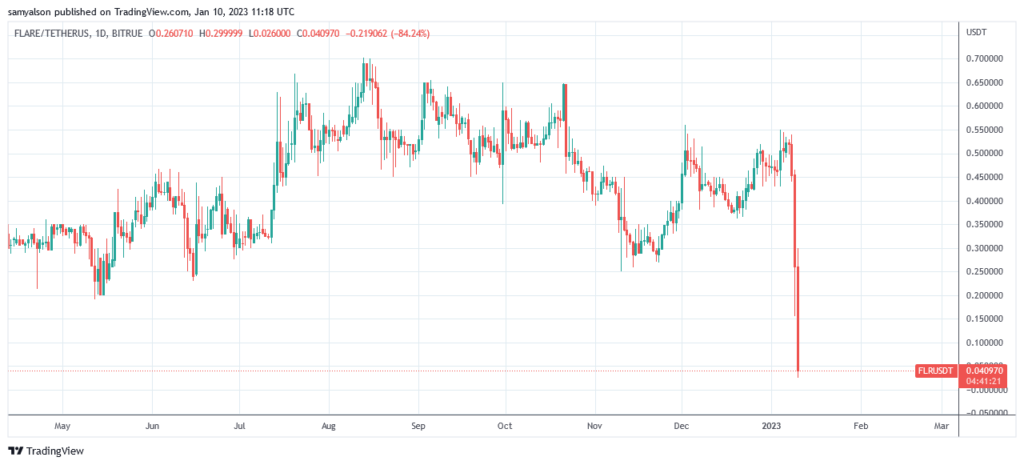- January 10, 2023
- Posted by: admin
- Category: BitCoin, Blockchain, Cryptocurrency, Investments
The long-awaited Flare (FLR) token airdrop took place at 23:59 UTC on Jan. 9, leading to a severe 83% drawdown over the last 24 hours.
FLR began trading in Jan. 2021, managing to hit an all-time high of $2.26 on May 1, 2021. It has since been caught in a macro downtrend that has approximately followed wider market movements, including the FTX sell-off in November.
The first sign of trouble showed on Jan. 8, with an 18% downside swing that closed the day at $0.451838. Jan. 9 saw a continuation to the selloff — resulting in a loss of 42% on the day. As of press time, the FLR token had bottomed at $0.025329.

Two-year delay in airdrop
FLR airdrop tokens were set to be distributed 1:1 with snapshotted XRP balances on Dec. 12, 2020.
Since the snapshot, several delays followed with no airdrop in sight, leading some to speculate fears of being dragged into the SEC vs. Ripple lawsuit was to blame.
It later emerged that the team had decided to slow roll out “to launch a canary network prior to launching the official network.” This process enabled thorough network testing, ensuring a more robust final product.
More than two years after the snapshot, 4.3 billion FLR tokens were airdropped on Jan. 9, in the first distribution round. This amounted to 15% of the total allocation; the remaining 85% will be paid out over the next 36 months but the precise distribution is subject to a community vote.
What is Flare?
Flare Network began as a DeFi ecosystem for Ripple but — during its two-year delay — has evolved into a “layer 1 oracle network.” This incorporates technologies such as native data acquisition protocols, the State Connector, and Flare Time Series Oracle.
State Connector refers to protocols enabling secure and scalable information transfer. While Flare Time Series Oracle is a decentralized data oracle drawing on over 100 independent providers.
Flare CEO and co-founder Hugo Philion said that the project gives developers secure and trusted data access to build apps on. This functionality can potentially facilitate new use cases in the blockchain and cryptocurrency sectors.
“This could enable new use cases to be built, such as triggering a Flare smart contract action with a payment made on another chain, or with input from an internet API. It also facilitates a new way of bridging, specifically to bring non-smart contract tokens to Flare for use in applications like DeFi protocols.”
The post Flare crashes 83% following two-year delayed airdrop appeared first on CryptoSlate.
